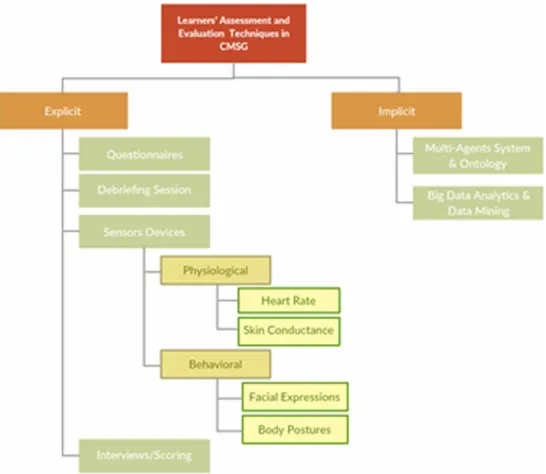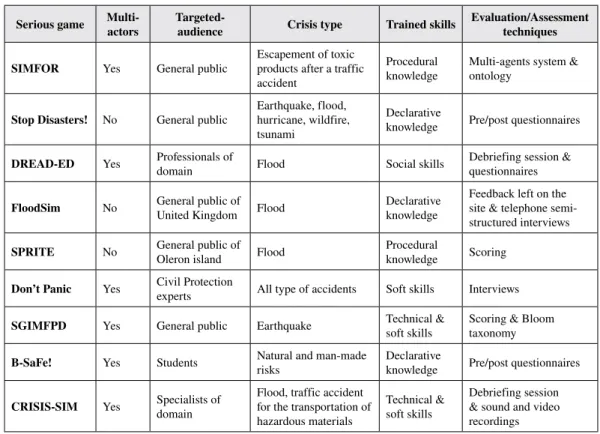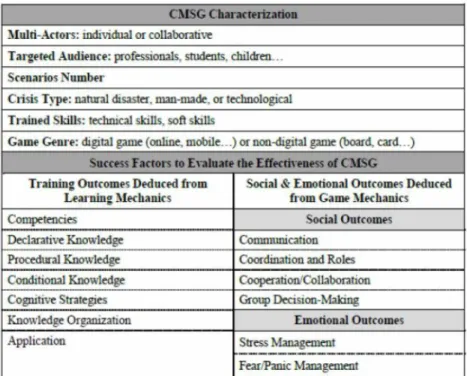HAL Id: hal-01819289
https://hal-amu.archives-ouvertes.fr/hal-01819289
Submitted on 24 Apr 2021HAL is a multi-disciplinary open access archive for the deposit and dissemination of sci-entific research documents, whether they are pub-lished or not. The documents may come from teaching and research institutions in France or abroad, or from public or private research centers.
L’archive ouverte pluridisciplinaire HAL, est destinée au dépôt et à la diffusion de documents scientifiques de niveau recherche, publiés ou non, émanant des établissements d’enseignement et de recherche français ou étrangers, des laboratoires publics ou privés.
Copyright
Management Serious Games: A Survey of the Current
State of Art
Ibtissem Daoudi, Raoudha Chebil, Erwan Tranvouez, Wided Lejouad Chaari,
Bernard Espinasse
To cite this version:
Ibtissem Daoudi, Raoudha Chebil, Erwan Tranvouez, Wided Lejouad Chaari, Bernard Espinasse. Towards a Grid for Characterizing and Evaluating Crisis Management Serious Games: A Survey of the Current State of Art. International Journal of Information Systems for Crisis Response and Management, IGI-Global, 2017, 9 (3), pp.76 - 95. �10.4018/IJISCRAM.2017070105�. �hal-01819289�
Towards a Grid for Characterizing
and Evaluating Crisis Management
Serious Games:
A Survey of the Current State of Art
Ibtissem Daoudi, ENSI, Manouba, TunisiaRaoudha Chebil, ENSI, Manouba, Tunisia
Erwan Tranvouez, Aix Marseille University, Marseille, France Wided Lejouad Chaari, ENSI, Manouba, Tunisia
Bernard Espinasse, Aix Marseille University, Marseille, France
ABSTRACT Overthelastfewdecades,interesthasgrownintheuseofseriousgames(SG)andtheirassessment inalmosteverysector.AprivilegedapplicationdomainofSGiscrisismanagement(CM)inwhich thesetoolsimprovecrisisbehaviorand/ormanagementinasafeenvironmentwhilereducing trainingcosts.However,itisdifficulttocharacterizeandevaluatesuchspecificSG.Thisarticle proposesacomprehensivegriddefiningfeaturesfordescription,analysisandevaluationofCrisis ManagementSeriousGames(CMSG).Firstofall,theauthorsintroduceSG,CMaswellasevaluation andassessmentconcepts,anddiscusstheirparticularchallengesbyhighlightingtheneedofusing assessmentandevaluationtechniquestosupportlearningand/ortraining.Then,theauthorspresent, classifyandcomparethemostrelevanttechniquesdedicatedtoaddressthisneedbyencompassing thestateoftheartoflearners’assessmentandevaluationapproachesusedinCMSG.Finally,this articlepresentsindetailtheproposedgridanddiscussesthemajorfindingsandcontributions. KEywoRdS
Characterization, Crisis Management, Evaluation, Grid, Learners’ Assessment, Serious Games, State of the Art
1. INTRodUCTIoN Inthelastfewyears,theincreasinguseofInformationandCommunicationTechnologies(ICT) hasofferedanewhorizonforusingsimulationandgamingasmethodologicaltoolsforaneffective learning/training(Walkeretal.,2011).Nowadays,considerableattentionhasbeenpaidtoanewclass ofgamescalled“SeriousGames”(SG)whichwascreatedfortrainingoreducationalpurposesrather thanpureentertainment(Alvarez,2007).Thankstotheirapproachcombiningseriousnessandfun aswellastheinterestingandusefulopportunitiestheyprovide(interactivity,immersion,simulation, etc.),theyhavebecomeverypowerfulandpopularlearningdevices(Boughzela,2014).Themain
goaloftheSGistomaketheknowledgeand/orcompetenciesacquisitionmoreeffectiveinawide rangeofsectorsincludingdefense,communication,education,andhealthbyincreasingthelearner motivationandengagementwhileplaying. CrisisManagement(CM)isexemplarasanapplicationdomainwhereSGdevelopmenthasgrown exponentiallyandthushasbeentheobjectofnumerousresearchstudiesinseriousgamesarea(Di Loretoetal.,2012a).CMpopularityresidesinexploringdifferenttypesofcrisis(naturaldisasters, terroristattacks,nuclearorindustrialaccidents,etc.)eachinvolvingmultipleroles(firefighters, medicalfirstresponders,police,civilprotection,etc.)andcollaborativebehaviors(evacuation,victim salvation,decisionprocess,etc.)(Daoudietal.,2017).Seriousgamesforcrisismanagement(CMSG) areconsideredasanewalternativetrainingapproachtoteachworkersdifferentkindsofskills(technical and/orsoft)andtotrainthemtomanageemergenciesinanengagingway(DiLoretoetal.,2012a). Intheliterature,severalresearchworkshavebeenproposedtoassessand/orevaluatelearners-playersusingvarioustechniquesinindividualand/orcollaborativetrainingcontextsofcrisis management.Theyfocusondifferentevaluationcriteriasuchas: • Learningaspectscoveringcompetencies/skills(Oulhacietal.,2015),andknowledge(Silvaet al.,2014;Anitaetal.,2015;Mendezetal.,2009); • Emotionalaspectsincludingstress,fear,andpanic(MoraandDivitini,2014;Nguyenetal.,2014); • Socialaspectsconsistingofcoordination(TheoOvanetal.,2015),cooperation(DiLoretoand Divitini,2013),andcommunication(Haferkampetal.,2011;DiLoretoetal.,2012b). AllthesestudiesshowagrowinginteresttoCMSGinimprovingandsupportingbothtechnical andsoftskills.Thisgrowinginterestisfollowedbyanincreasingneedtoidentifythecharacteristics (descriptivefeatures)andthecommonevaluationcriteria(successfactors)inordertocomparethem andtomeasuretheireffectivenessforlearning.Meetingthisneedrequiresspecificaspectsand principlesthatcanbevalidatedandappliedbydomainexpertsand/orevaluatorsinordertocharacterize andevaluatethesuccessofseriousgamesenvironmentsforcrisismanagementtraining.Considerable effortsandpublicationsarecurrentlybeingdevotedtoresearchingandevaluatingCMSG,thereby increasingboththequantityandthequalityofsuchevaluations(Oulhacietal.,2015;Haferkamp etal.,2011;TheoOvanetal.,2015;Caroleetal.,2016;Silvaetal.,2014;Soorajetal.,2016;Di Loretoetal.,2012b;Anitaetal.,2015;Mendezetal.,2009;Tena-Cholletetal.,2016).Considerable weaknessesremain,however,includingthefollowing:
• The absence of comprehensive classification for comparative evaluation techniques usedinCMSG. • TheabsenceofanevaluationanalysisgridforcharacterizingandevaluatingCMSG. • Alackofimplicit(“stealth”)techniquesfordata-gatheringandassessmentinCMSG. • AlackofworksconsideringbothemotionalandsocialaspectsinevaluatingcollaborativeCMSG. Inshort,despiteapromisingincreaseinmethodsandfindings,wecontinuetolackaclassification ofevaluation/assessmenttechniquesusedinCMSGaswellasanoverarchinganevaluationanalysis gridfordescribingandevaluatingsuchenvironments.Inthisperspective,thisarticletriestobridge thesetwomainresearchgapsbybuildinganewclassificationofevaluation/assessmenttechniques inCMSGandanewGridofcriteriaforCharacterizingandEvaluatingCrisisManagementSerious Games(G-CE-CMSG).Theclassificationaimstopresentandclassifythemostexistingtechniques
andmethodsutilizedforassessingand/orevaluatinglearnersduringatrainingsessionbasedona particularCMSG.ThegridaimstogatherinformationonthecharacteristicsofCMSGandtoidentify theirsuccessfactorsinordertomaximizetheiruse.Indeed,thedefinedelementsintheproposed gridshouldbetakenintoaccountwhiledevelopinganoveltechniqueforassessingand/orevaluating learnersduringtheirinteractionswithagivenCMSG. Theremainderofthisarticleisorganizedasfollows.Section2overviewssomebackground knowledgeonSGconcept,CMdomainaswellasassessmentandevaluationprocesses.Section3 resumestheanalysisofthemostrecentexistingworksinCMSGevaluationandpresentsasurvey includingseveralseriousgamesdesignedforcrisismanagementtraining.Section4describesthe proposedG-CE-CMSGanddetailsitsprincipalelements.Section5discussesourmajorfindingsand contributions.Section6concludesthearticleandoutlinesourfutureresearchdirections. 2. BACKGRoUNd Theaimofthissectionistogiveanoutlineofthekeyconceptsandterminologiesusedintherest ofthisarticleconcerningSGconcept,CMdomainaswellasassessmentandevaluationprocesses. 2.1. Serious Game Today,seriousgames,alsocalledgame-basedlearning,havegainedundeniablepopularitysince societiesandinstitutionsdecidedtoimplementthemaspartoftheirtrainingprograms(Boughzela, 2014).Asurveyintheworldofseriousgameshasprovidedawiderangeofdefinitions. Thefirstformaldefinitionoftheconceptwasintroducedby(Abt,1970).Inhisbook,Abtgives acleardefinitionofseriousgames:“Gamesmaybeplayedseriouslyorcasually.Weareconcerned withseriousgamesinthesensethatthesegameshaveanexplicitandcarefullythought-outeducational purposeandarenotintendedtobeplayedprimarilyforamusement.Thisdoesnotmeanthatserious gamesarenot,orshouldnotbe,entertaining.”Inrecentyears,(MichaelandChen,2005)defined seriousgamesas:“Gamesthatdonothaveentertainment,enjoymentorfunastheirprimarypurpose”. (Zyda,2005)definedthisconceptas:“Amentalcontest,playedwithacomputerinaccordancewith specificrules,thatusesentertainmenttofurthergovernmentorcorporatetraining,education,health, publicpolicy,andstrategiccommunicationobjectives.”Accordingto(Alvarez,2007),aseriousgame is:“Acomputerapplication,whoseoriginalintentionistocombinewithconsistency,bothserious aspectsas,butnotlimitedto,non-exclusive,teaching,learning,communication,orinformationwith playfulspringsfromthevideogame.” Tosummarizeaccordingtothevarietyofdefinitions,wecansaythatseriousgamesaregames inwhichlearningisthefirstpurpose.Thesegamesaredesignedtocreateaskilldevelopment environmentforthelearner-playerwhileretainingthesamefocusedmotivationcontextof“fun” games(Alvarez,2007).Thedefinitionscitedabovehaveallowedustohighlightthemostimportant propertiesofthistool: • Itmaintainsbalancebetweenkeepinggame-playfunontheonehandandlearningaspecton theotherhand • Ittargetsmultiplelearningobjectivessuchasteaching,training,educatingandraisingawareness aboutspecialissues • Itisusedinnumerousareaslikehealth,education,defense,military,emergencymanagement, politics,advertising,business • Itisintendedforallagegroupsincludingchildren,adolescents,adultsandolderpeople
supportedbyacomputer-basedlearningenvironment.However,therearesomedifferencesbetween themaccordingtothegamefuldesign.Infact,gamificationistheapplicationofgameelementsina non-gamecontext(thefinallearningenvironmentisnotagame).Seriousgamesareindeedgames aimingtolearnaboutdevelopingaparticularcompetencebyfocusingon“game-playrules”tofollow. Simulationgamescanbeconsideredasasub-categoryofseriousgamesthatsimulateareal-world scenariooflearning:theyaregameenvironmentswhichrecreatealearning/trainingsituationthat occursinreallife(Calliesetal.,2017). Thepresentedworkcanbeappliedinseriousgamesaswellassimulationgamesforcrisis managementtraining. 2.2. Crisis Management Disastersaremoreandmorearecurrentphenomenonandmaybeextremelydamaging(DiLoretoet al.,2012a).Theyareextremelyharmfulsincetheythreatenpeople’slives(deaths,injuries,diseases, etc.)andheavilyaffecttheeconomy.Theincreasingcrisisfrequencyandthegrowingdamagesrequire effectivecrisismanagementprocessesinordertoensurepromptandeffectiveresponseaswellas reducelossesunderstressfulandcriticalconditions(Sagunetal.,2009).Crisismanagementcan bedefinedastheapplicationofstrategiesdesignedtohelpanorganization,itsstakeholders,orthe generalpublicdealwithanunexpectedandsignificantnegativeevent(Walkeretal.,2011). Theaimofcrisismanagementistobewellpreparedforcrisisandtoensurearapidandadequate responsetothecrisissituation.Crisisresponseandmanagementisaprocessinvolvingdifferenttypes ofcompetencies,fromveryspecifictechnicalprocedurestosoftskills.Itinvolvesalsodifferentkinds ofworkersfromdifferentorganizations(medicalunit,police,civilprotectionetc.)havingtowork simultaneouslyandinahurrytoreachtheircommongoalconsistingincrisisreduction(DiLoreto etal.,2012a).Theexistingcrisissituationsarecommonlyclassifiedintothreemaincategoriesas follows(Sagunetal.,2009): • Natural Disasters:Aredisastersresultingfromnaturalhazardsthatthreatenhumanlife,property, andtheenvironmentitselfsuchasearthquakes,hurricanes,forestfires,andfloods. • Human-Made Disasters:Alsocalledasman-madedisasters,aredisastrouseventscausedby humans,i.e.terroristattacksandpollution. • Technological Crises:Aredisasterscausedbyhumanapplicationofscienceandtechnology likeindustrialaccidents,oilspills,cyberattacks,andairplanecrash. Inordertocombatcrisisandtogobacktonormalstateinaquickandeffectivemanner,every organizationshouldhaveacrisiscommunicationteam,composedofkeyemergencyactors,who shouldapplyallthephasesofCMprocess.Ingeneral,theCMprocessinvolvesthefollowingactions (Sagunetal.,2009): • Preparedness Phase:Inthisstage,membersofemergencyteamshouldidentifytheneedsand requirementsofmitigationaswellasthreatsandpossibleconsequencesofthecrisissituation. • Response Phase:Duringtheresponsestagetothesituation,membersofemergencyteam shouldrecognizetheseriousnessoftheprobleminordertogenerateanappropriateresponse; theyshouldapplytheirtechnicalexpertiseandsocialskillstosavehumanlife,andtohelpmeet victim’sphysicalandmentalneeds. • Recovery Phase:ThefinalstageofCMprocessiswhenthingsbegintoreturntonormal state;membersofemergencyteamshouldtraintogeneratenewsolutionsaswellasto reconstructdestroyedbuildingsandinfrastructureinordertodevelopstrongerresistance toanyfuturedisasters.
Crisisanddisastertrainingisahighlycomplexandcostlytaskthatrequiressophisticated trainingapproachessuchastrainingmaterials,coaching,anddebriefingsessions(Sagunetal.,2009). Recently,anewalternativelearningapproachcalled“SeriousGames”hasemergedtorepresentan idealtoolforteachingworkersdifferenttypesofskillsinanengagingway(Walkeretal.,2011). Seriousgamesforcrisismanagementofferaninterestingcomplementtotraditionaltraining,as theyareveryusefultrainingtoolsforpeople,bothcivilianandemergencyactors,whohaveto manageacrisis.Theyhavethepotentialtodevelopbothtechnicalskills(expertiseandknowledge forapplyingemergencyoperatingprocedures)andnon-technicalskills(alsocalledsoftskillsorbest practiceslikecommunication,coordination,andstressmanagement)underpressureforindividuals andteams(DiLoretoetal.,2012a).Besides,CMSGaredevelopedinordertoraiseawarenessand consciousnessaboutthemostrelevantproblemslinkedtotheCMdomain.Theuseofseriousgames toteachconceptsrelatedtothefieldofemergencymanagementnotonlyprovidesacost-effective, time-savingalternative,itallowsanoptimallearningbybridgingtogethertheoryandpracticeina simulationenvironment(Soorajetal.,2016).
2.3. Evaluation and Assessment
Inthissub-section,wedefinedifferencesandsimilaritiesbetweenthetwoterms“Assessment”and “Evaluation”inalearningcontext,andweshowtheneedofresearchworksinCMSGevaluation. Bothassessmentandevaluationrequire(qualitativeand/orquantitative)dataaboutlearnersand utilize(directand/orindirect)measurestounderstand,analyze,andevaluatelearners’behaviors duringalearningsession(Daoudietal.,2017).Assessmentisdefinedasaprocessofcollectingand interpretingdataaboutlearnersinordertoprovidethemfeedbacksontheirfailuresandprogress andtomakethenimprovementsoftheircurrentperformances.However,evaluationaimstomake judgments/conclusionsaboutseriousgameeffectivenessandusefulnessforlearningonthebasisof aparticularsetofcriteria(Bellottietal.,2013;PetriandWangenheim,2016;Alletal.,2015). Formoreclarity,assessmentcanbedescribedasa“formative”measurementimplemented throughouttheentirelearningprocessforthepurposeofdiagnosinglearners’actions/activitiesand identifyingareasofimprovementtoincreaselearningquality(Daoudietal.,2017).Evaluationisa “summative”(final)assessmentconductedattheendofalearningprocessinthepurposetotestthe overalllearners’achievementsandtodrawjudgmentsaboutlearningquality(Daoudietal.,2017). So,wecanconcludethatassessmentisconcernedwithlearningprocess,whileevaluationfocuses ontheproduct(thelearningenvironment).Figure1summarizesthekeydifferencesandsimilarities betweenassessmentandevaluation.
Despitethedifferencesbetweenthesetwoterms,theutilizedtechniquestoanalyzelearners’ behaviorswhileplayingcanbeusedforbothassessmentandevaluationpurposes.Forthisreason, wewillconsider,intherestofthisarticle,that“assessment”and“evaluation”canbeassociated togetheraccordingtotheusedtechniques. Thegrowinginterestforcrisismanagementseriousgameshasraisedparticularneedsintermsof learners’assessmentandevaluation(Oulhacietal.,2015).Learners’assessmentinCMSGrepresents actuallyanimportantresearchsubjectthatoftenrelieson“human”post-gamedebriefingbasedon logsanalysis,questionnairesorinterviews.Infact,thelearner’sassessmentisperformedmanually eitherbythelearneritself(whichwecalledself-assessment)orbyhumanmonitors(Oulhacietal., 2015).Inaddition,producingacollectiveassessmentinthiskindofSG,especiallyincollaborative CMSG,remainsadifficulttask;that’swhytheassessmentofthecollectiveperformanceisnot enoughaddressedintheliteratureandreliesontheexperienceofindividualgameplayers(Oulhaci etal.,2015).However,itlooksveryimportanttoproduceacollectiveassessmentofaparticular CMSGsinceitcontainsglobalandusefulinformationaboutthegameeffectivenessfortraining. Moreover,itshouldbenotedthatthecarried-outevaluationsinthefieldofCMSGconsiderinmost casescompetenciesandknowledgeacquiredbyplayersduringagamesessionwithoutexploiting theiremotionalandsocialstatesintheevaluationprocess(Daoudietal.,2017).Therefore,theissue ofassessing,bothindividuallyandcollectively,emotional,socialandcognitivestatesoflearners-playersisnotyetstudied.Alltheseaspectsconstituteabigchallengeandneedtobeaddressedin futureresearchworkinginthisarea. Thenextsectionaimstoreportthemostinterestingworkspublishedinthedomainoflearners’ assessmentandevaluationincrisismanagementseriousgames.
3. LEARNERS’ ASSESSMENT ANd EVALUATIoN IN CRISIS MANAGEMENT SERIoUS GAMES
Thissectionfocusesonlearners’assessmentandevaluationinCMSGandoffersasurveyofstate oftheartofassessmenttechniquestosupportlearning/training.Then,weprovideaclassificationof thecurrenttechniquesusedinCMSG,throughwhich,wehopetocontributeinthefutureresearch intheareaofCMSGevaluation.
3.1. Classification of Learners’ Assessment and Evaluation Techniques
Untilnow,therearenumerousresearchstudiespublishedinthedomainoflearners’assessmentand evaluationinCMSG.Inthisarticle,weproposetoclassifythemostexistingrecentstudiesintotwo mainapproachesinrelationwiththetechniquetypeusedinevaluation/assessmentprocess.Thefirst approachgathersalltechniquesthatassesslearners-playersexplicitlylikequestionnaires(Haferkamp etal.,2011;Silvaetal.,2014;DiLoretoetal.,2012b;Anitaetal.,2015)andsensorsdevices(Mora andDivitini,2014).ThesecondapproachfocusesontechniquesthatassesslearnersusingArtificial Intelligence(AI)modelsandmethodssuchasdataminingandbigdataanalytics(Zagoreckietal., 2013;Yietal.,2011;EmmanouilandNikolaos,2015),aswellasmulti-agentsystems(Oulhacietal., 2015).Themaindifferencebetweenexplicitandimplicitapproachesisrelatedtothewaysofcollecting andanalyzingdataaboutlearners(Daoudietal.,2017).Ontheoneside,anexplicitapproachaims tousedirectandobviousmeasuresofcollectingandanalyzingdataaboutlearners.Therefore,this approachrequireshumaninterventionoutsidetheSGinordertocollectdataandgiveanassessment oflearners’behaviorduringplaying.Ontheotherside,animplicitapproachaimstocollectandto analyzedataaboutlearnersinanindirectandunobtrusiveway,withoutdisruptingthehighlevelof engagementprovidedbySG.Hence,animplicitapproachoflearners’assessmentisintegratedinthe SG,anddoesnotrequireanyhumanintervention.
3.1.1. The Proposed Classification Inthissection,weproposeanewclassificationoflearners’assessmentandevaluationtechniques inCMSG.Figure2presentstheorganizationofthekeyaspectsthatconstituteourclassification. Aspreviouslyexplained,learners’assessmentandevaluationinCMSGcanbeachievedexplicitly orimplicitly.Theexplicitassessmentcanbeaccomplishedusingaquestionnaire,aninterview,a debriefingsessionorsomesensordevices.Infact,self-reportquestionnaires(Haferkampetal., 2011;Silvaetal.,2014;DiLoretoetal.,2012b;Anitaetal.,2015)arefrequentlyemployedbecause theyaresimpleandeasytoimplement,buttheyrepresentasubjectiveassessmentthatrelyonnon-exhaustiveplayersopinions(Daoudietal.,2017).Inaddition,questionnairesdisruptthehighlevel ofengagementprovidedbySGsincetheyrequirestoppingthelearnerfromplayingandrequesting himtoanswersomequestions.Moreover,theuseofhardwaredevicesandequipmentsprovidesan explicitwaytoassessthelearnerwhileinteractingwithSGenvironments(MoraandDivitini,2014). Thistechniqueisbasedonsensorsprovidingquantitativeinformationdescribingbehavioraland/or physiologicallearners’reactions.Inthiscontext,dataiscapturedinrealtimewithoutstoppingthe learner’splayinganditiseasytomanipulateandtoanalyze.However,itobviouslyrequirestheuseof additionalsophisticalhardwareandsoftwareequipmentthatcanbeexpensive(Daoudietal.,2017).
Learners’ assessment can also be achieved implicitly. This is realized by exploiting the techniquesofartificialintelligenceinordertoanalyzeandassessthebehavioroflearnerswhile theyplaySG.Inthiscontext,wecancitebigdataanalyticsanddataminingtechniques(Zagorecki etal.,2013;Yietal.,2011;EmmanouilandNikolaos,2015),aswellasmulti-agentsystems
andontology(Oulhacietal.,2015).Allthesetechniqueshavethemajoradvantageofadopting implicitmodelsandmethodsofAIforlearners’assessmentwithoutaffectingthehighlevelof engagementprovidedbySG.So,thistypeofassessmentisintendedtosupportlearning,maintain motivation,andincreaselearners’engagementinthevirtualwordofthegame.However,such implicittechniquesrepresenttheproblemofvalidationandreliabilityoftheirresultscompared toexplicittechniques.Infact,implicittechniquesusingartificialintelligencealgorithmsrequire asetofmeasuresabletoquantifytheaccuracyandconsistencyoftheirobtainedresultsinorder tovalidatethem.Forexample,machinelearningbasedtechniquesdesignedtoevaluatelearners’ sentimentsandemotionsareconsideredasvalidandreliabletechniquesiftheyproduceaccurate andconsistentresultscomparedtothoseextractedfromsensorsdevices.
3.1.2. Explicit Techniques of Learners’ Assessment and Evaluation in CMSG
Thissectionidentifiestechniquesthathavealreadybeenusedtoassessthelearnerbehaviorexplicitly. Wepresentessentiallyself-reportquestionnaires,sensorsdevices,anddebriefingsessions. • Self-Report Questionnaires:Learners’assessmentcanbeperformedthroughassessingthe learners’answerstoaquestionnaire(oranonlinesurvey)atthebeginning(Silvaetal.,2014; Anitaetal.,2015),duringorattheendofagame-basedlearningsession(Silvaetal.,2014; Anitaetal.,2015;Haferkampetal.,2011).Forexample,(Haferkampetal.,2011)presentedan assessmentofthe“DREAD-ED”(DisasterReadinessthroughEducation)gamefortrainingof socialskillsincludingcommunication,teamwork,emotionalintelligence,andgroupdecision makinginacrisissituation.Theassessmentprocesswasperformedviaaquestionnaireusinga 5-pointLikertscalemeasuring,onaquantitativelevel.Inthisprocess,thethoughtsandlearner opinionsonthetrainingsessionarecombinedwithqualitativedataobtainedfromthetutor’s interviewduringgameplay.Basedonthiscombination,theauthorscanconcludewhetherthe gamecontributestothelearningofsocialskills.Moreover,(Silvaetal.,2014)invitedchildren from10to13years,residentsofthecityofRiodeJaneiroinBrazil,tousetheseriousgame “StopDisasters”inordertobuildasafetycultureforemergencies.Toanalyzeandassesslearners’ performancesandtoverifyifthegamereallyimprovestheawarenessofriskysituations,the participantsansweredquestionnairesbeforeandafterplayingthegameaboutthreemainaspects namelygame-play,missions,andgamescenarios. • Sensors Devices:Advancesinthebranchofneuroscienceshaveledtothedevelopmentofvarious equipmentandhardwaredevicesabletocontinuouslydetectandrecognizehumanemotionsvia facialexpressions,bodypostures,speech,andphysiologicalsignals(Daoudietal.,2017).Several workshaveshownthatthesemeasurescanprovideanindicationoflearners’emotions.For instance,(MoraandDivitini,2014)showedtheusefulnessofcollectingdatafromtheWATCHiT sensorduringatrainingeventtosupportdebriefinginthecrisismanagementandpreparedness fieldbyaddressingtwodifferentscenariosCroMARandProcedureTrainer.CroMARsupports disastermanagersduringin-situdebriefingafterlargeevents,whereasProcedureTrainersupports ateaminreflectingafterthesimulationofamedicalemergencyprocedure.Thisdebriefingbased onsensordataisconsideredasaformofassessmentwithexplicitattentiontoemotionsaswell asideasandbehaviorsoflearners. • Debriefing Sessions:Learners’assessmentcanbeperformedalsothroughadebriefingsession afterthetrainingprocess.ManyworksinCMcontexthaveshownthatthistechnique,referringto aconversationalsession,revolvesaroundthesharingandexaminingofinformationafteracrisis eventhastakenplace(Tena-Cholletetal.,2016;Haferkampetal.,2011).Indeed,adebriefing processcanserveavarietyofpurposes.Forexample,thesesessionscanbeusedforanalyzing thecriticalaspectslinkedtotheintervention,reporting/discussingindividualandcollective performancesofplayers,understandingtheirmisconceptions/errors,orlearningfromexperience
3.1.3. Implicit Techniques of Learners’ Assessment and Evaluation in CMSG
Inthissection,wepresentimplicittechniquesthathavebeenusedintheliteraturetoassessthelearner duringtheinteractionwithaCMSG.Thesetechniquesarebasedonspecificartificialintelligence modelsandmethods.Wepresentessentiallyassessmenttechniquesbasedonmulti-agentsystems combinedwithanontologyaswellasbigdataanalyticsanddataminingtechniques.
• Multi-Agent Systems Combined with Ontology:Learners’assessmentwhileplayingaserious gamecanbesupportedbytheagenttechnology.Forexample,(Oulhacietal.,2015)presented amulti-criteriaanddistributedassessmentapproachoflearnersinacollaborativecontext illustratedwiththe“SIMFOR”SGdedicatedtocrisismanagement.Inthispurpose,theystartedby proposingamethodologicalframeworkforlearners’assessmentwhichisbasedontheconceptof EvaluationSpaceallowingtheproductionofindividualandcollectiveassessmentsandtargeting themanagementofdistributedandheterogeneousinformation(Oulhacietal.,2015).Inorderto implementthismethodologicalassessmentframework,theydevelopedanagent-basedarchitecture permittingtoimproveNon-PlayerCharacter(NPC)adaptabilityandtosupportindividualand collectivelearners’assessment.Infact,theauthorsusemulti-agentsystemstodevelopsoftware agentssimulatingthebehaviorofhumanplayers(learners)andvirtualplayers(NPC).Thanks totheBDImodel(Beliefs,Desires,Intentions),theseagentsaredesignedtocollectdataabout learners,andassesstheirbehaviorduringthegamesession(Oulhacietal.,2015).Allknowledge usedorproducedbytheassessmentmoduleisstoredasontologyinthedomainmodelandthe learnermodel.Thedomainontologydescribesthegeneralconceptsofcrisismanagementdomain butadaptedtotheSIMFORcontextlikeproceduralknowledge,andenvironmententities(actors, disaster,infrastructure,etc.).Thelearnerontology,instantiatedforeachlearner-agent,represents hismentalstateatatimet.Althoughtheinterestofthisassessmentprocess,theauthorsdidnot consideremotionalstatesoflearnersduringtheiractivities.Indeed,emotionsplayanimportant roleinCMtrainingandshouldbetakingintoaccountduringlearners’assessmentinorderto produceacompleteanalysis.
• Big Data Analytics and Data Mining:Recentworksinthefieldofdisasterandcrisis managementapplieddataminingandbigdataanalyticstechniquestoassessandsupportthe groupdecision-makingasanimportantfactorofsoftskills(Zagoreckietal.,2013;Yietal.,2011) (EmmanouilandNikolaos,2015).Forinstance,(Yietal.,2011)exploitedthesetechniquesto automatizeanalysisandassessmentoflargevolumesofcollecteddatafromheterogeneoussources indifferentphasesofCMinordertoassistdecision-makingprocess.Theygathereddifferent typesofdata(quantitativeorqualitative,structuredorunstructured,staticordynamic)produced inacrisissituationinordertoidentifyusefulpatternsandtoextractrelevantknowledgeaboutthe consideredincident.Infact,duringacrisissituation,theresponsibleworkersmustquicklymake decisions(Yietal.,2011).Thequalityofthesedecisionsdependsonthequalityoftheavailable information.Anobjective,comprehensive,andaccurateassessmentofthesituationcanempower decision-makersduringacrisistomakeconvenientdecisions,takesuitableactionsforthemost affectivecrisismanagement(Yietal.,2011).Therefore,thegoalofthedataminingprocess istohelpdecision-makersunderstandcharacteristicsofemergencies,selecttheappropriate alternative,andpredictwhatwilloccurinthefuturebyanalyzingavailablecrisisinformation usingacollectionofdataminingfunctions.
weareinterestedtoCMSGevaluationandassessment,wedescribeinthefollowingseriousgames whichhavebeensubjectofevaluationworksusinginterestingtechniques.
• SIMFOR (Simulation and Formation) (Oulhaci et al., 2015):Isamulti-playersserious gameforcrisismanagementtrainingallowingdifferentpeople(specialistsofthefieldand non-professionals)tolearndifferentskills(sharedorspecific)inthesamegamesession.The objectiveofthisgameistocreateatrainingenvironmentthatimmersesusersinarealscenario ofcrisismanagementsituation.
• FloodSim (Mendez et al., 2009):Isafreeonlinegameaimingtoraiseawarenessaboutflooding dangerintheUnitedKingdomandtoincreasecitizens’engagementthroughanaccessible simulation.ThegoalofthegameistotrainpeopleoftheUnitedKingdomhowtoprotectfrom floodsthatdamagetheeconomyandthreattheirlives.
• SPRITE (Participatory Simulation of Territorial Risks) (Carole et al., 2016):Isaserious gameplacingtheplayer(populationorelectedrepresentative)intheroleofadecisionmaker andlettinghimexplorevariouspoliciesinordertoraisehisawarenessaboutcoastalfloodrisk ontheOleronIsland.SPRITEhasadoublepedagogicalmission:informingtheplayerabouta majorbutoftenunder-estimatedrisk(coastalflood);andforcinghimtoreflectonpoliciesfor managingthisrisk.
• Stop Disasters! (Silva et al., 2014):Isafreeonlinegamedesignedtoraiseawarenessofnatural disasters’significantimpactandtoexplainsimpleprecautionsthatcansavelives.Thegame teachesfamiliestheskillsneededtomanagenaturalcatastropheslikeearthquakes,tornadoes, hurricanes,andfloods.
• DREAD-ED (Disaster Readiness through Education) (Haferkamp et al., 2011): Is a collaborativeseriousgamethatenablescrisisunitstotrainsoftskills(communicationandgroup decision-making)inavirtualenvironment.Thegameplacesitsusersinacrisismanagement teamthatisdealingwithanevolvingemergency(ahugefireclosetoachemicalpark).Thegame aimstoencourageitsuserstocriticallyreflectontheirdecisionsmadewithinthegameandto traincommunicationinstressfulsituations.
• Serious Game on Incident Management Frameworks for Post Disaster Management
(SGIMFPD) (Sooraj et al., 2016):Isamulti-playersseriousgamethatteachescommunication
and collaboration concepts during post-disaster operations in a safe and secure training environment.Thegamepresenttwoessentialconceptsforeffectivepostdisastermanagement: RapidDamageAssessmentandIncidentManagementSystem.Thegamecanalsobeusedas atooltoincreasecommunitypreparednessbyteachingvillagersaneffectivedisasterresponse. • Don’t Panic (Di Loreto et al, 2012b):Isacooperativeboardgamedesignedtoenhancesoft
skillsforcivilprotectionworkersinthecrisismanagementfield.Thegame(1)addsthefun elementtotrainingaboutstressfulsituationslinkedtopanicmanagementand(2)teachessocial skillssuchascommunication,teammanagementandcoordination.
• B-SaFe! (Anita et al., 2015):Isamulti-playersboardgamedesignedtoincreasecitizens’ awarenessofman-madeandnaturalrisksandtogivethemconsiderationsonhowtopreparefor andreacttoabroadrangeofadversities.
• CRISIS-SIM (Tena-Chollet et al., 2016):Isaseriousgamefordecision-makersfacingupa majorcrisis.Thegameaimstotrainalltheskillsnecessaryforemergencymanagementthrough thedecision-makers’experienceconsistingof:anticipation,communication,cooperation,stress management,decision-making,andstrategicsteering. Formoreclarity,themaincharacteristicsofthepreviouslydescribedCMSGarerecapitulated inTable1. AccordingtoTable1,wecaneasilynotethatthemostanalyzedseriousgameshavebeen
sessions. For example, Stop Disasters! game, B-SaFe! game and DREAD-ED game were assessedbasedonquestionnairesaimingtocollectinformationaboutlearners’behaviorand knowledge during a game session. Furthermore, serious games Don’t Panic and FloodSim wereassessedviaqualitativeinterviewsinordertoreportthinking,emotions,attitudes,and perceptionsofplayersduringplaying.Theanalysisshowsthatdespiteitslimits,themostused explicittechniqueisassessmentviaquestionnaires.Table1showsalsothatalimitnumberof seriousgameshaveusedimplicittechniquestoobtainlearners’assessments.Forinstance,the seriousgameSIMFORintegratesamulti-agentarchitectureinordertoproducebothindividual andcollectiveassessments. Thefollowingsectionpresentsourmaincontributionconsistinginthepropositionofanevaluation analysisgridforcharacterizingandevaluatingcrisismanagementseriousgames.
4. TowARdS A GRId FoR CHARACTERIZING ANd EVALUATING CRISIS MANAGEMENT SERIoUS GAMES
ThestateoftheartcarriedoutinthedomainofCMSGevaluationshowedthatthereisno evaluation grid designed especially to CMSG. To fill this research gap, we developed an evaluationanalysisgridbasedonalistofCMSGsuccessfeatures.Thisgridwillbethebase ofatheoreticalframeworkforcharacterizingandevaluatingCMSG.Inthissection,webegin
Table 1. CMSG summary
Serious game Multi-actors Targeted- audience Crisis type Trained skills Evaluation/Assessment techniques
SIMFOR Yes Generalpublic Escapementoftoxicproductsafteratraffic accident
Procedural
knowledge Multi-agentssystem&ontology
Stop Disasters! No Generalpublic Earthquake,flood,hurricane,wildfire, tsunami
Declarative
knowledge Pre/postquestionnaires
DREAD-ED Yes Professionalsofdomain Flood Socialskills Debriefingsession&questionnaires
FloodSim No GeneralpublicofUnitedKingdom Flood Declarativeknowledge Feedbackleftonthe site&telephonesemi-structuredinterviews
SPRITE No GeneralpublicofOleronisland Flood Proceduralknowledge Scoring
Don’t Panic Yes CivilProtectionexperts Alltypeofaccidents Softskills Interviews
SGIMFPD Yes Generalpublic Earthquake Technical&softskills Scoring&Bloomtaxonomy
B-SaFe! Yes Students Naturalandman-maderisks Declarativeknowledge Pre/postquestionnaires
CRISIS-SIM Yes Specialistsofdomain Flood,trafficaccidentforthetransportationof hazardousmaterials Technical& softskills Debriefingsession &soundandvideo recordings
4.1. overview of the Proposed Grid Ourresearchaimstocharacterize,analyzeandevaluateCMSGtoimprovethemandtomaximize theireffectiveness.InthefieldofSG,effectivenessisdefinedas“…thesuccessfulattainmentofits intendedgoalsunderreal-worldconditionstomaximizeitsexternalvalidity…”(Alletal.,2015). OurcontributionentitledG-CE-CMSG(GridforCharacterizingandEvaluatingCrisisManagement SeriousGames)isinspiredbystudiesfocusedoncriteriausedtoevaluatetheeffectivenessofdigital game-basedlearning(Alletal.,2015)(Bedwelletal.,2012)andtoassesstheuseofseriousgames inhighereducation(Boughzela,2014).TheproposedgridisusefultoassistandsupportCMSG evaluatorsordomainexpertsinverifyingtheeffectivenessofaparticulargamefortrainingskills. Ontheonehand,theproposedgridallowscharacterizingtheseriousgamebydefiningalistof descriptivefeatureslikegamenature(single-playerormulti-players),crisistype(naturalorhuman-made),trainedskills(technicaland/orsoft),gamegenre(digitalornon-digital),andtargetedaudience (professionals,generalpublic,etc).Ontheotherhand,thegridallowstheevaluationofCMSGbasing ondifferentlearners’aspectsincludingemotional,socialandcognitivestates.Theseaspectsare deducedfrombothlearningandgamemechanicsoftheseriousgame(Bedwelletal.,2012)andare appliedinacrisismanagementcontext.Inshort,theproposedG-CE-CMSGprovidesaclassification schemethatcouldbeconsideredasadescriptiveandevaluationtoolbygivingqualitativeinformation todescribesomecharacteristicsofthegameandtojudgeifitiseffectivetouse.Table2givesa syntheticviewoftheG-CE-CMSG.
4.2. detailed description of the Proposed Grid: Structure and Selected Criteria
Inordertoensurealogicstructureoftheproposedgridandtofacilitateitsreadability,weproposeto divideitintotwomainthemesincludingseveralanalyticalcriteria.Thesethemesprovidearichsupport tobothcharacterizeandevaluatethesuccessofagivenseriousgameforcrisismanagementtraining.
Thefirsttheme,called“CMSGCharacterization”,givesabriefdescriptionoftheSG.Itis composedofasetofthemostimportantcriteriausedtodescribethecharacteristicsofSGand consistingof: • Multi-Actors:Individualorcollaborative; • Crisis Type:Natural,technologicalorman-made; • Trained Skills:Technicaland/orsoft; • Scenario Number; • Targeted Audience:Professionals,generalpublic,children,students,etc. • Game Genre:Digital(stand-alone,online,mobile,etc.)ornon-digital(board,card,etc.) Thesecondthemecontainsallrelevantcommoncriteriausedtoevaluatethesuccessofagiven CMSGforlearning/training.Thistheme,called“SuccessFactorstoEvaluatetheEffectivenessof CMSG”,isdivideditselfintotwosub-themesaccordingtotwotypesofdesiredoutcomes.Foreach sub-theme,differentsub-componentsareshowed.Infact,wesuggestdistinguishingtwocategories ofoutcomesthatshouldbeconsideredwhenevaluatingCMSGconsistingoftrainingoutcomesas wellassocialandemotionaloutcomes.Fortheseoutcomes,severalcriteriamustbeused.Intherest ofthissub-section,wepresentindetaileachoutcomecitedabove:
• Training Outcomes Deduced from Learning Mechanics:Themostcrucialelementrequired tomeasuretheeffectivenessofaparticularSGistheachievementofthetraining/learninggoals fixedbythegame-designer/developer(Alletal.,2015).ParticularlyinCMSGcontextand basingonresearchworksinIntelligentTutoringSystems(ITS)(Oulhacietal.,2015),training outcomes,representingthecognitivestateoflearner,areprimordialtoevaluatethesuccess ofagivenCMSG.Theyincludeseverallearningaspectsdeducedfromrelevantpedagogical resourcesoftheseriousgamecalled“learningmechanics.”Bylearningmechanics,wemean theadoptedpedagogicaltechniquestopresentdifferenttrainingoutcomessuchascompetencies, declarativeknowledge,proceduralknowledge,andcognitivestrategies.Concerningtheacquired knowledge,weshouldbeawareofthreekindsofcontentknowledgeconsistingof:procedural, declarative,andconditional.Proceduralknowledgeisknowledgeofhowtoapplythestepsin aparticularprocess.Anexampleofsuchknowledge,appliedinCMdomain,isknowinghow toprocesstosavevictims’livesduringabigaccident.Declarativeknowledgeisthefactual information(theoreticalknowledge)thatoneknows;itcanbedeclaredasspokenorwritten. Anexampleofsuchknowledgeisknowingthedifferentstepstoperforminordertosave victims’livesduringacrisissituation.Conditionalknowledgeisknowledgeaboutwhento useaprocedure,skill,orstrategyandwhennottouseit;whyaprocedureworksandunder whatconditions.Forinstance,learners-playersneedtorecognizethatCMproblemrequires savingvictims’livesaspartofitssolution.
• Social and Emotional Outcomes Deduced from Game Mechanics:Thiskindofoutcomeis notrelatedtothelearningcontentorthegameasalearningtool,butitisrelatedtothegameas anentertainmentmean,andmorespecificallytotoolsofgame-play(Bedwelletal.,2012).In fact,socialandemotionaloutcomesincludeseveralsocialandemotionalaspectsdeducedfrom relevantplayresourcesoftheseriousgamecalled“gamemechanics”suchashumaninteraction, gamefictionorfantasy,immersion,gamerules,andchallenge.
andgroupdecisionmaking.Inreality,CMischaracterizedbyacleardefinitionofrolesatthe organizational,team,andindividuallevels;andallthemembersofaCMteamneedtocoordinate theiractionstogettheworkdone(DiLoretoetal.,2012a).Cooperation/collaborationplaysalsoan importantroleintraininggamessincetrainingofcrisisworkersisacooperative/collaborativetask. Cooperationmaytakeplaceinter-sectors(cooperationbetweendifferentagencieslikefirefightersand medicalunits),intra-sector(cooperationbetweendifferentworkersofagivensector)andbetween crisisworkersandcitizens(DiLoretoandDivitini,2013).Inaddition,communicationbetweenthe teammembersisatthecoreofthetrainingexperience,andteachingcommunicationstylesistoo usefultomanagecrisiseventsandtofosterteambuilding(Haferkampetal.,2011).Moreover,the groupdecisionmakingprocessisessentialtosuccessfulgroupperformanceinanyemergencyresponse plan(Yietal.,2011).Infact,eachplayerinthegroupshouldsharehisprogressandalltherelevant informationwitheachothertoimprovedecisionmakingensuringsoabetterresponsetothecrisis. Ontheotherhand,inaCMcontext,stressmanagementandfear/panicmanagementareessential aspectsthatshouldbeconsideredinordertomakeeffectivetheresponsetoacrisissituation(Nguyen etal.,2014).Theseaspectsarestronglyrelatedtosomegamemechanicslikethechallenge(referring tothepresentationandnatureofproblems),thegamefiction/fantasy(describingthenatureofthegame worldandstory),theimmersion(determiningtheplayers’perceptualandaffectiverelationshipwith thegamefiction),andthegamerules(definingthemethodadoptedtosolveproblemsinthegame) (Bedwelletal.,2012).Forexample,(Nguyenetal.,2014)focusonfearemotionsinceitrepresents themostpredominantemotionincrisissituationsandhasagreatimpactonthehumandecision-makingprocessandbehavior.Theyproposedtointegrateemotions,inparticularfear,insimulation ofevacuationscenarioduringacrisis.Tothebestofourknowledge,thereisnoworkaimingtodetect andtoevaluateemotionalstatesoflearners-players(fear,sadness,anger,etc.)duringacollaborative scenarioofcrisismanagementbasedonaparticularseriousgame. Thenextsectionaimstodiscussthemajorfindingsandcontributionspresentedinthisarticle. 5. dISCUSSIoN Thecurrentstateofartoflearners’assessmentandevaluationinCMSGshowed,asmentionedin Introductionsection,theabsenceofaclassificationforcomparativeassessmenttechniquesusedin CMSGaswellastheabsenceofanevaluationanalysisgridforcharacterizingandevaluatingCMSG. Tofillthesetheoreticalgaps,weproposedfirstanewclassificationoflearners’assessmentand evaluationtechniquesforCMSG.Thisclassificationaimstoclassifythemostrecentexistingworksin twomainapproaches:implicitandexplicit.Foreachoftheseapproaches,wepresentedsometechniques currentlyusedinexistingCMSG.Oursecondcontributionconsistsinatheoreticalframeworkfor characterizingandevaluatingCMSG.Inthiscontext,theproposedmultidimensionalgridisfocused onthefollowingtwoessentialdesiredoutcomes:training,aswellassocialandemotionaloutcomes. ThiswillnotonlyprovidetoevaluatorsorresearchersinSGdomainrelevantaspectstocharacterize andevaluateCMSG,butitwillalsobeusefulforgame-designers/developerssinceitunderlinesthe expectedcriteriahavingtobeconsideredinCMSGimplementation. Furthermore,thecarried-outliteraturestudyshowedalackofworksconsideringbothemotional andsocialaspectsinevaluatingcollaborativeCMSG.Indeed,theassessmentofCMSGisacomplex processhavingtoconsiderseveralparametersrelatedtoactionsandactivitiesperformedbytheplayer, thelearningcontext,andtheplayerprofile.Thecomplexityofsuchassessmentincreasesinthecaseof multi-playersSGsincewemustalsotakeintoaccountsocialinteractionsbetweeninvolvedplayers.In CMcontext,theconsideredcharacteristicsofplayerprofileshouldincludecognitiveaspectslikethe initiallevelofskills,andknowledgeacquiredduringagamesession;emotionalaspectslikefear,and stress;aswellassocialaspectslikecommunication,andcoordination.Inordertofillthisresearchgap, weproposetoperformbothanassessmentprocessontheindividualleveltoassessseverallearners’
CMSG.Infact,duringtheirinteractionswithacollaborativeCMSG,anassessmentprocessshould takeplaceinordertoassessdifferenttypesofaspectscharacterizingthelearnerprofileandconsisting ofemotional,social,andcognitivestate.Formoredetails,theassessmentoflearneremotionalstate providesrelevantinformationabouthissentiments,feelings,emotions,andattitudeswhileplaying thegame.Inaddition,assessingthesocialstateofthelearnergivesusefulinformationconcerning hissocialrelationshipswithotherlearners.Moreover,thelearnercognitivestateneedstobeassessed tovalidatehisacquiredknowledgeandcompetenciesinCMdomain.Alltheseassessmentsallow ustocreateindividualfeedbacksbasedontheprofileofeachplayerduringthegame-basedtraining session.InordertoevaluatetheeffectivenessofagivenCMSG,acollectiveevaluationshouldbe producedbyexploitingtheresultsofindividuallearners’assessments.Thiscollectiveevaluationallows ustogenerateaglobalfeedbackontheconsideredgameanditseffectivenessforcrisismanagement training.Figure3givesaglobalarchitectureofourvision.Inwhatfollows,wewilldescribethe adoptedevaluation/assessmenttechniquestoputinpracticeourvisionandinparticulartoevaluate differentlearners’statesincludingcognitive,emotionalandsocialstates. AneffectiveSGforcrisismanagementmustachieveitslearninggoalsfixedbythegame-designer. Toattainthisobjective,acollectiveevaluationprocessofplayers’competenciesandcognitive knowledgeshouldtakeplaceattheendofatrainingsession.Thisevaluationcanbeperformed throughadebriefingsession.Infact,thiswayremainsusuallythepreferredmethodforgathering players’feedbacksafteragamesessionespeciallyabouttheirperformances.Thedebriefingsession aimstoanalyzeindividualandcollectiveperformancesofplayers,andtodiscusstheirerrorsand progress.Thissessioncaninvolvedifferentkindsofparticipantssuchaslearners-players,domain experts,evaluators,game-designers/developersandresearchersinordertoproviderichanalysis oftheacquiredknowledgeonaqualitativelevelandthustogenerateanevaluationofthegame effectivenessfortraining. Emotionalaspectisthestartingpointforallofthereactionsthatwehavetowardacrisis. Negativeemotionssuchasstress,fear,anxiety,anger,andallunpleasantandunhelpfulfeelingsare thefirstobstacletoestablishapositiveresponsetoacrisis.That’swhyitisessentialtoconsiderand tounderstandtheroleofemotionsinmanagingacrisissituation(Daoudietal.,2017).Inreality, extractingandanalyzingemotionsintext-basedcommunicationprovideinsighttobetterunderstand howactorscommunicateandperformduringdisasters(Beigietal.,2016).SentimentAnalysis(SA) is“….thetaskofdetecting,extractingandclassifyingopinions,sentiments,emotions,andattitudes concerningdifferenttopics,asexpressedintextualinput…”(Guthieretal.,2016).SA,alsoknown asopinionmining,hasbeenshownasaneffectivetooltodetecttweetsthatcontributetosituational awarenessinCMdomain(Beigietal.,2016;HarvinderandRajiv,2015;Torkildsonetal.,2014). However,thecurrentapproachesforSAonlyfocusonsocialmediaplatforms,inparticulartwitter, inordertodetectandanalyzepeople’emotionsduringacrisissituation.InacollaborativeCMSG,
weplantodetectandassesslearners’emotionsandsentimentsusingSAtechniques.Indeed,SA fromtextmessagesexchangedbetweenplayersduringagame-basedtrainingsessionisusefulfor understandingtheirexperiencesandanalyzingtheiremotions.SAcanbeaccomplishedusingvarious techniquessuchasMachineLearning(ML),NaturalLanguageProcessing(NLP),structuredand unstructuredDataMining(DM)(Guthieretal.,2016).Inshort,sentimentanalysisisanimportant approachthatcanbeusedtounderstandandanalyzetheattitudes,sentimentsandemotionsofactors managingacrisissituation. Tothebestofourknowledge,therearealimitednumberofstudiesaimingtoassesssocialaspects likecommunication,coordination,cooperation,andgroupdecision-makinginmulti-playersCMSG. However,itisessentialtoaddresstheroleofsocialinteractionsbetweenthedifferentmembersof aCMteaminaffectingtheirindividualandcollectiveperformances(TheoOvanetal.,2015).In particular,communicationaswellascoordinationandrolesarecrucialsocialfactorsinexplaining bothteamandactorperformanceduringCMtraining(Haferkampetal.,2011;TheoOvanetal., 2015).RecentworksofcommunicationandcoordinationnetworksinCMhaveshowedthatnetwork theory,especiallySocialNetworkAnalysis(SNA),isausefulmethodforstudyingcommandand control(TheoOvanetal.,2015).Asocialnetworkconsistsofasetofnodes(players-learners)thatare connectedbyties(communicationfloworsocialrelationship)(ErgunandUsluel,2016).Thanksto SNAmethodanditsmeasures,learners’patternsofcommunicationandinteractioncanbemeasured, analyzed,andvisualized.InacollaborativecontextofCMSG,SNAprovidesasetofusefulindicators tomeasureandanalyzecoordinationattheteamandactorlevels(TheOvanetal.,2015).Infact, coordinationattheteamlevelcanbeassessedusingnetworkdensitymeasures.Densityisdefined astheproportionoftiesexistinginthesocialnetworktoallprobableties(ErgunandUsluel,2016). Thismeasureisveryrelevanttodisplaythefrequencyofinformationflowandtopredictthediffusion rateofsharedknowledgebetweenactors.Forexample,ahighvalueofdensityincollaborative learningenvironmentsshowsanimportantqualityofthesharedknowledgeandsoahighlevelof teamcoordination(ErgunandUsluel,2016).Ontheotherhand,coordinationattheactorlevelcanbe assessedintermsofnetworkcentralityindicatorslikein-degreecentrality(thenumberofin-coming links),out-degreecentrality(thenumberofout-goinglinks),andclosenesscentrality(theaverage lengthoftheshortestpathbetweenthenodeandallothernodesinthegraph).Thecentralityofan actorinasocialnetworkisrelevanttodescribehisposition,toexaminehowhissocialinteractions evolveovertime,andtounderstandhisperformance(TheoOvanetal.,2015).Indeed,thepositionof anactorinthenetworkispositivelyrelatedtohislearningperformance.Anactorwhohasacentral position(highlevelofcentrality)inanetworkisbetterabletoachievehisperformancegoals(Ergun andUsluel,2016).ToresumeappliedtocollaborativeCMSG,SNArepresentsapowerfulandrich methodofmeasuringandassessingsocialinteractionsbetweenactorsbyfocusingonspecificaspects ofthenetworkconnection,ortheentirenetworkasawhole(SchlauchandZweig,2015). Tosummarize,intheliteraturethereareamultitudeofworksdevelopingmethodsandtechniques forassessingCMSGbasedondifferentcriteria.Severalamongthemarelimitedtodrawjudgments aboutlearners’behaviors,buttheydon’texploittheobtainedresultstoimprovetheenvironmentor adapttheSGtocurrentcharacteristicsofplayers.Totacklethisproblem,wesuggest,asafuture work,todevelopanovelapproachforimplicitassessmentandadaptationinCMSGbytakinginto accountcognitive,emotionalandsocialaspectsofplayers. 6. CoNCLUSIoN Thisarticlepresentsasurveyofthecurrentstateofartinlearners’assessmentandevaluationin CMSG.Thestudyincludesmajorthemesidentifiedintheliteraturebysummarizingthemain techniquesandcriteriausedinCMSGevaluation.Infact,weproposedfirstlyanewclassification oflearners’assessmentandevaluationtechniquesinCMSGwherefutureworkscanbeclassified.
ofthemostsuitabletechniqueaccordingtohis/herneedsinordertoassessand/orevaluatelearners duringatrainingsessionbasedonaparticularCMSG. Unlikesimilarworks,weprovidedalsoastructureofthemostimportantdescriptivefeaturesand evaluationcriteria,intheformofagrid,thatrespectivelycharacterizeandevaluateaparticularCMSG fortraining.Thus,theproposedgridshowsrelevantandusefulinformationfordeepunderstandingof thegamecharacteristicsandproperties.Moreover,thegridprovidesrichinformationaboutsuccess factorstovalidatetheeffectivenessofaCMSGfortraining/learning.Fromtheoutcomeofour investigationitispossibletoconcludethatthenovelG-CE-CMSGisactuallynotonlyatheoretical elaborationofaCMSGevaluationinstrument,butalsoastartingpointforfurtherresearchinthis area.Theresultsshouldbeofinteresttoresearchersandgame-designers/developersinterestedinthe integrationofCMSGintheireducational/trainingprograms. Onthebasisofthefindingspresentedinthisarticle,workontheremainingissuesiscontinuing andwillbepresentedinfuturepapers.Infact,thenextstageofourresearchwillbethedevelopment ofanovelapproachfor“stealth”assessmentandadaptationofanexistingcollaborativeCMSG supportedby“iScen”:asoftwaretoolforcreatinginteractivescenarioswithmultimediacontent specificallyintendedforcrisissimulation,management,andtraining.Thisapproachwillconsider bothemotionalandsocialaspectsinordertoproviderelevantinformationtolearnersabouttheir emotionalandsocialstatesandthustoimprovetheirtrainingresults.




